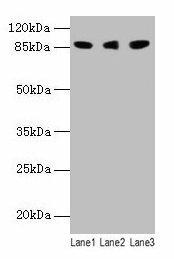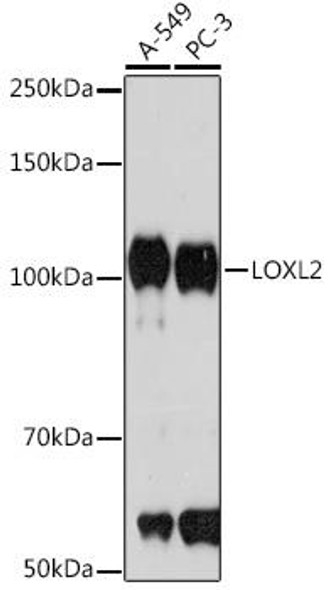Description
| Antibody Name: | Loxl2 Antibody (PACO27997) |
| Antibody SKU: | PACO27997 |
| Size: | 50ug |
| Host Species: | Rabbit |
| Tested Applications: | ELISA, WB |
| Recommended Dilutions: | ELISA:1:2000-1:10000, WB:1:1000-1:5000 |
| Species Reactivity: | Mouse, Human |
| Immunogen: | Recombinant Mouse Lysyl oxidase homolog 2 protein (26-776AA) |
| Form: | Liquid |
| Storage Buffer: | Preservative: 0.03% Proclin 300 Constituents: 50% Glycerol, 0.01M PBS, PH 7.4 |
| Purification Method: | >95%, Protein G purified |
| Clonality: | Polyclonal |
| Isotype: | IgG |
| Conjugate: | Non-conjugated |
 | Western blot All lanes: Loxl2 antibody at 14µg/ml Lane 1: 293T whole cell lysate Lane 2: A549 whole cell lysate Lane 3: A431 whole cell lysate Secondary Goat polyclonal to rabbit IgG at 1/10000 dilution Predicted band size: 88, 82 kDa Observed band size: 88 kDa . |
| Background: | Mediates the post-translational oxidative deamination of lysine residues on target proteins leading to the formation of deaminated lysine (allysine). When secreted in extracellular matrix, promotes cross-linking of extracellular matrix proteins by mediating oxidative deamination of peptidyl lysine residues in precursors to fibrous collagen and elastin. Acts as a regulator of sprouting angiogenesis, probably via collagen IV scaffolding. When nuclear, acts as a transcription corepressor and specifically mediates deamination of trimethylated Lys-4 of histone H3 (H3K4me3), a specific tag for epigenetic transcriptional activation. Involved in epithelial to mesenchymal transition (EMT) via interaction with SNAI1 and participates in repression of E-cadherin, probably by mediating deamination of histone H3 By similarity. Acts as a regulator of chondrocyte differentiation, probably by regulating expression of factors that control chondrocyte differentiation. |
| Synonyms: | Lysyl oxidase homolog 2 (EC 1.4.3.13) (Lysyl oxidase-like protein 2), Loxl2 |
| UniProt Protein Function: | LOXL2: Mediates the post-translational oxidative deamination of lysine residues on target proteins leading to the formation of deaminated lysine (allysine). When secreted in extracellular matrix, promotes cross-linking of extracellular matrix proteins by mediating oxidative deamination of peptidyl lysine residues in precursors to fibrous collagen and elastin. Acts as a regulator of sprouting angiogenesis, probably via collagen IV scaffolding. When nuclear, acts as a transcription corepressor and specifically mediates deamination of trimethylated 'Lys-4' of histone H3 (H3K4me3), a specific tag for epigenetic transcriptional activation. Involved in epithelial to mesenchymal transition (EMT) via interaction with SNAI1 and participates in repression of E- cadherin, probably by mediating deamination of histone H3. Also involved in E-cadherin repression following hypoxia, a hallmark of epithelial to mesenchymal transition believed to amplify tumor aggressiveness, suggesting that it may play a role in tumor progression. Acts as a regulator of chondrocyte differentiation, probably by regulating expression of factors that control chondrocyte differentiation. Belongs to the lysyl oxidase family.Protein type: Cell adhesion; EC 1.4.3.13; Secreted; Secreted, signal peptide; OxidoreductaseCellular Component: basement membrane; chromosome; extracellular region; extracellular space; membrane; nucleoplasm; nucleus; proteinaceous extracellular matrixMolecular Function: chromatin binding; copper ion binding; metal ion binding; methylated histone residue binding; oxidoreductase activity; oxidoreductase activity, acting on the CH-NH2 group of donors, oxygen as acceptor; protein-lysine 6-oxidase activity; scavenger receptor activity; transcription corepressor activityBiological Process: chromatin modification; collagen fibril organization; endothelial cell migration; endothelial cell proliferation; epithelial to mesenchymal transition; histone modification; negative regulation of transcription, DNA-dependent; positive regulation of chondrocyte differentiation; protein amino acid deamination; protein modification process; regulation of transcription, DNA-dependent; response to copper ion; response to hypoxia; sprouting angiogenesis; transcription, DNA-dependent |
| UniProt Protein Details: | |
| NCBI Summary: | |
| UniProt Code: | P58022 |
| NCBI GenInfo Identifier: | 225579028 |
| NCBI Gene ID: | 94352 |
| NCBI Accession: | NP_201582.2 |
| UniProt Secondary Accession: | P58022,Q8BRE6, Q8BS86, Q8C4K0, Q9JJ39 |
| UniProt Related Accession: | P58022 |
| Molecular Weight: | |
| NCBI Full Name: | lysyl oxidase homolog 2 |
| NCBI Synonym Full Names: | lysyl oxidase-like 2 |
| NCBI Official Symbol: | Loxl2 |
| NCBI Official Synonym Symbols: | 1110004B06Rik; 4930526G11Rik; 9430067E15Rik |
| NCBI Protein Information: | lysyl oxidase homolog 2 |
| UniProt Protein Name: | Lysyl oxidase homolog 2 |
| UniProt Synonym Protein Names: | Lysyl oxidase-like protein 2 |
| Protein Family: | Lysyl oxidase |
| UniProt Gene Name: | Loxl2 |
| UniProt Entry Name: | LOXL2_MOUSE |






